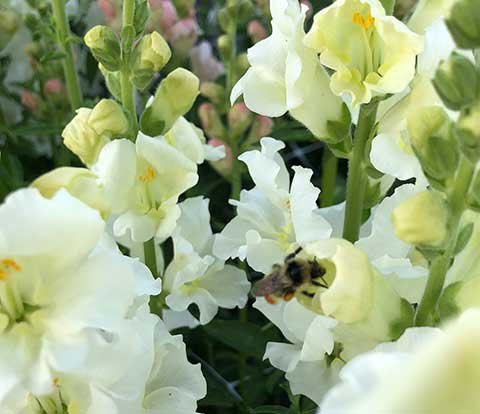Want to Save the Bees? Plant the Right Flowers
My dear friend Holly’s daughter wears a t-shirt with a picture of a bee saying “If we die, we are taking you with us.”
That little meme is cute and true at the same time.
Many reports are in agreement with the UN Food and Agriculture Organization (FAO) that 75% of the world’s food crops rely on pollination. Some put that number even higher. At the end of the day, there is a lot of truth in Ella’s T-Shirt.
Honey bees are a critical part of the puzzle for sure. Most of the produce that you get from the grocery store or Farmers Market every day relied on honey bees for pollination. I often think of beekeepers as the last nomadic farmers in our country as they start the year pollinating almonds in California, then move up to Washington State for tree fruit and sometimes finish the year in the Dakotas where they can make that fabulous clover honey. So when most folks think of saving the bees, they think of keeping more honey bees.
If you are genuinely interested in beekeeping, and they are fascinating creatures for sure, you should absolutely go for it.
But, there is so much more to saving the bees than making more of them. And, there are some very simple things you can do right now to be part of the solution.
Let’s remember that honey bees are not the only game in town. Native bees, bumble bees, hummingbirds and other beneficial insects also perform important pollinator chores.
When Steve’s (my beloved sweetheart) post docs and graduate students come out to the farm to work in the bee yard, they love to go into the flower farm at the end of the day to observe and collect what’s out there. We see a lot of honey bees and hummingbirds in the flower farm every day. But the students always find amazing collections of native bees and bumbles. The flowers provide an abundant habitat to support them and the population is flourishing.
This time of year, as you are planning your garden, there are so many easy to grow and gorgeous cutting flowers that are also excellent habitat to support our pollinator friends.
If you are feeling a sense of despair about the bees and want to save them, the simple act of planting flowers will go a long way. Plus, you get to enjoy the beauty yourself. A win for everyone.
A little planning now will ensure that you have pollinator-friendly flowers throughout the season so the supply does not dry up.
See the queen? She has a sticker with a tiny number kind of like the ear tags we put on livestock
Crocuses are the first pollinator friendly flower out of the gate. I love hearing from the bee team when they see that distinctive dark orange pollen in the hives once the crocuses start. That is an inexpensive and super easy to grow flower that you can just tuck into the soil in the fall and forget about it.
Right after crocuses? Dandelions. We consider them a wildflower and let them run free and you can too. They are an early and critical food source when not much else is blooming. They create a bridge for pollinators between spring and summer flowers. Biennials such as Foxglove, Campanula, and Sweet Rocket are also good flowers that bridge spring to summer, feed the pollinators and keep us in flowers. Because biennials bloom in their second year, we plant plenty fresh ones each season to ensure a steady supply.
Here is a list of easy to grow annual cutting- flowers you can pop into your own garden to boost that all important pollinator habitat from summer to fall. There are more, but if you just planted from this list, you’ll have cut flowers all season long and the pollinators would have a bottomless buffet.
Alyssum
Calendula
Cerinthe (honey wort)
Cleome
Cosmos
Dahlias
Daisies
Echinacea (cone flower)
Eryngium
Forget-me not
Goldenrod
Lavender
Salvia
Snapdragons (we love watching bees dive in and out of the mouths of the snaps! They open and close as the bees enter and exit so their little mouths are working all day – so fun)
Stonecrop
Sunflowers
Verbena
Yarrow
There are plenty of culinary herbs that pollinators like too: sage, thyme, borage, chives, dill, basil, rosemary, and mint. Plant these workhorses and do double duty. Save the bees and up your cooking game.
If you have bigger landscaping projects in mind this year, flowering trees are the best because of their huge masses of blossoms. if you are choosing ornamentals, pick one that bees like. Steve always complains when people plant ornamental Bradford Pears. Sure they’re pretty, but they have nothing for bees. Instead, go for a gorgeous Linden or a Horse Chestnut. We have 2 horse chestnuts near the farmhouse that must be at least 80 years old if not more – they look like one massive tree and they are positively vibrating with bees when they bloom – honey bees in the morning and bumbles in the afternoon. It is one of my favorite things.
As you go through the seed catalogs this winter and dream of the gardens ahead, I hope you’ll include a nod to pollinators in your plans. You’ll be doing your part to save the world while you create beauty to enjoy all season. I’d love to see what you plant and hope you drop me a note to share.



